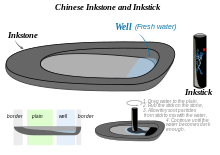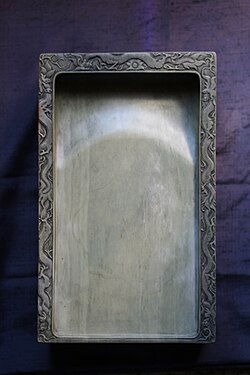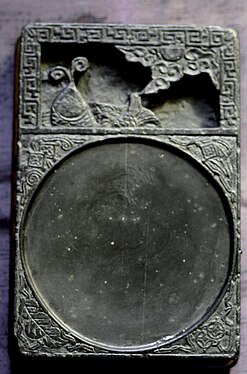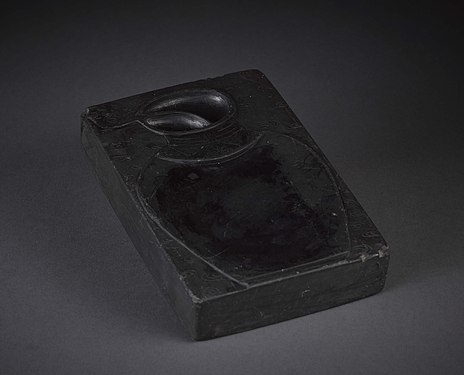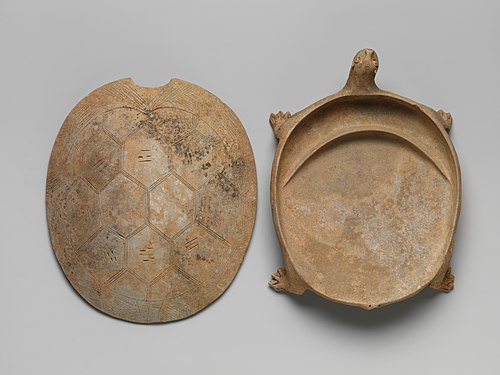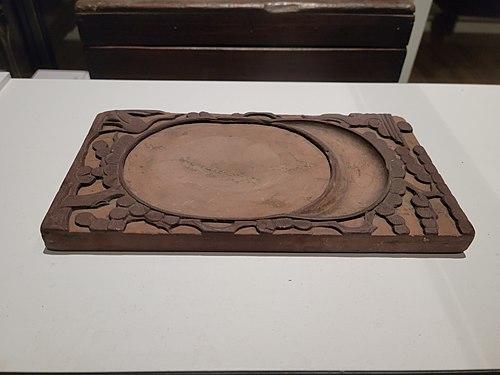
Chinese art is visual art that originated in or is practiced in China, Greater China or by Chinese artists. Art created by Chinese residing outside of China can also be considered a part of Chinese art when it is based on or draws on Chinese culture, heritage, and history. Early "Stone Age art" dates back to 10,000 BC, mostly consisting of simple pottery and sculptures. After that period, Chinese art, like Chinese history, was typically classified by the succession of ruling dynasties of Chinese emperors, most of which lasted several hundred years. The Palace Museum in Beijing and the National Palace Museum in Taipei contains extensive collections of Chinese art.

Ink wash painting ; is a type of Chinese ink brush painting which uses washes of black ink, such as that used in East Asian calligraphy, in different concentrations. It emerged during the Tang dynasty of China (618–907), and overturned earlier, more realistic techniques. It is typically monochrome, using only shades of black, with a great emphasis on virtuoso brushwork and conveying the perceived "spirit" or "essence" of a subject over direct imitation. Ink wash painting flourished from the Song dynasty in China (960–1279) onwards, as well as in Japan after it was introduced by Zen Buddhist monks in the 14th century. Some Western scholars divide Chinese painting into three periods: times of representation, times of expression, and historical Oriental art. Chinese scholars have their own views which may be different; they believe that contemporary Chinese ink wash paintings are the pluralistic continuation of multiple historical traditions.
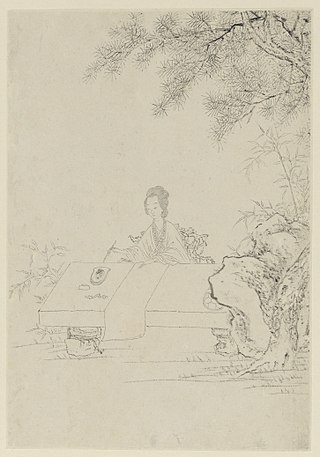
Wei Shuo, courtesy name Mouyi (茂猗), sobriquet He'nan (和南), commonly addressed just as Lady Wei (衛夫人), who lived during the Eastern Jin, was one of the most famous of all Chinese calligraphers in history. She was a pioneer, who established new rules that developed the regular script. As a teacher, her most notable disciple was Wang Xizhi.
For most of its history, China was organized into various dynastic states under the rule of hereditary monarchs. Beginning with the establishment of dynastic rule by Yu the Great c. 2070 BC, and ending with the abdication of the Xuantong Emperor in AD 1912, Chinese historiography came to organize itself around the succession of monarchical dynasties. Besides those established by the dominant Han ethnic group or its spiritual Huaxia predecessors, dynasties throughout Chinese history were also founded by non-Han peoples.

Ink brushes are paintbrushes used in Chinese calligraphy as well as in Japanese, Korean, and Vietnamese which all have roots in Chinese calligraphy. They are also used in Chinese painting and other brush painting styles. The ink brush was invented in China around 300 B.C. Together with the inkstone, inkstick and Xuan paper, these four writing implements form the Four Treasures of the Study.

Chinese calligraphy is the writing of Chinese characters as an art form, combining purely visual art and interpretation of the literary meaning. This type of expression has been widely practiced in China and has been generally held in high esteem across East Asia. Calligraphy is considered one of the four most-sought skills and hobbies of ancient Chinese literati, along with playing stringed musical instruments, the board game "Go", and painting. There are some general standardizations of the various styles of calligraphy in this tradition. Chinese calligraphy and ink and wash painting are closely related: they are accomplished using similar tools and techniques, and have a long history of shared artistry. Distinguishing features of Chinese painting and calligraphy include an emphasis on motion charged with dynamic life. According to Stanley-Baker, "Calligraphy is sheer life experienced through energy in motion that is registered as traces on silk or paper, with time and rhythm in shifting space its main ingredients." Calligraphy has also led to the development of many forms of art in China, including seal carving, ornate paperweights, and inkstones.

The Lantingji Xu, or Lanting Xu, is a piece of Chinese calligraphy work generally considered to be written by the well-known calligrapher Wang Xizhi (303–361) from the Eastern Jin dynasty (317–420).

Southern Tang was a dynastic state of China that existed during Five Dynasties and Ten Kingdoms period. Located in southern China, the Southern Tang proclaimed itself to be the successor of the Tang dynasty. The capital was located at Nanjing in present-day Jiangsu Province. At its territorial peak in 951, the Southern Tang controlled the whole of modern Jiangxi, and portions of Anhui, Fujian, Hubei, Hunan, and Jiangsu provinces.

Stone rubbing is the practice of creating an image of surface features of a stone on paper. The image records features such as natural textures, inscribed patterns or lettering. By rubbing hard rendering materials over the paper, pigment is deposited over protrusions and on edges; depressions remain unpigmented since the pliable paper moves away from the rendering material. Common rendering materials include rice paper, charcoal, wax, graphite or inksticks. Over time, the practice of stone rubbing can cause permanent damage to cultural monuments due to abrasion. For an artist, stone rubbings can become an entire body of creative work that is framed and displayed.

Four Treasures of the Study is an expression used to denote the brush, ink, paper and ink stone used in Chinese calligraphy and spread into other East Asian calligraphic traditions. The name appears to originate in the time of the Southern and Northern Dynasties.

Inksticks or ink cakes are a type of solid Chinese ink used traditionally in several Chinese and East Asian art forms such as calligraphy and brush painting. Inksticks are made mainly of soot and animal glue, sometimes with incense or medicinal scents added. To make ink, the inkstick is ground against an inkstone with a small quantity of water to produce a dark liquid which is then applied with an ink brush. By adjusting the strength and duration of the ink grinding process, artists and calligraphers may adjust the concentration of the produced ink to suit their tastes.
Zhiyanzhai was the pseudonym of an early and mysterious commentator of the 18th-century Chinese novel Dream of the Red Chamber. This person was a contemporary of the author Cao Xueqin who knew the author intimately enough to be regarded as the chief commentator of his work while it was still unpublished. Most early hand-copied manuscripts of the novel contain red or black-inked commentaries by a few unknown commentators, considered authoritative enough to be transcribed by scribes into subsequent generations of copies. Zhiyanzhai was the most prominent of these commentators. Early copies of Dream were known as 脂硯齋重評石頭記. These versions are known as 脂本, or "Rouge Versions", in Chinese. They are the manuscripts with the highest textual reliability.
Dorothy Ko is a Professor of History and Women's Studies at the Barnard College of Columbia University. She is a historian of early modern China, known for her multi-disciplinary and multi-dimensional research. As a historian of early modern China, she has endeavored to engage with the field of modern China studies; as a China scholar, she has always positioned herself within the study of women and gender and applied feminist approaches in her work; as a historian, she has ventured across disciplinary boundaries, into fields that include literature, visual and material culture, science and technology, as well as studies of fashion, the body and sexuality.

Qian Daxin was a Qing dynasty scholar-official, historian, and linguist. He served as a commissioner of education and examinations in Guangdong Province.
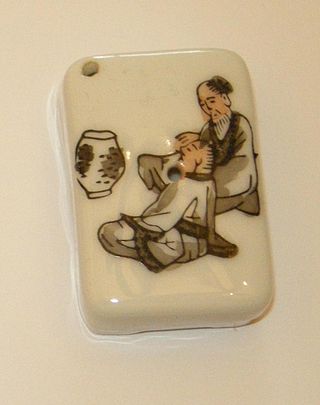
A water-dropper is a small device used in East Asian calligraphy as a container designed to hold a small amount of water. In order to make ink a few drops of water are dropped onto the surface of an inkstone. By grinding an inkstick into this water on the inkstone, particles come off and mix with the water, forming ink.

Duanzhou or Duan Prefecture was a zhou (prefecture) in imperial China in modern Guangdong, China, centering on modern Zhaoqing. Duan Prefecture was a major production center of inkstones.
Gu Erniang was a famous Chinese inkstone artist who lived in the Qing dynasty, during the reign of Kangxi Emperor. Throughout her career, she was regarded as the best of her profession in China.

Xingguo Temple is a Buddhist temple located in Zhangqiu District of Jinan, Shandong.

Handicrafts produced during the Qing dynasty (1644–1911) were objects designed and hand-made by craftsmen. They were heavily ornate, incorporating Tibetan, Middle Eastern, Indian, and European techniques. The design or decorative aspect of the craft was as important as the crafting technique itself and Qing artisans were particular about the materials they used, such as jade (yu), stones, and wood. In their designs artisans drew heavily from a number of motifs, both mythical and natural. Certain areas in China became well-known for specific types of handicrafts; for example, Jingdezhen was known as the capital of porcelain. During the Qing era, Imperial Workshops built in Beijing brought together artisans and raw materials that were once only obtainable in disparate regions. This allowed for the combining of technologies and materials to produce new types of handicrafts. The tributary system also brought new sources for materials and artisans that were not from the production centers.
Hanfu accessories refers to the various form of fashion accessories and self-adornments used and worn with hanfu throughout Chinese history. Hanfu consists of many forms of miscellaneous accessories, such as jewelries, yaopei, ribbons, shawls, scarves, and hand-held accessories, etc.
